Mode-Matching-Based Sound Field Recording and Synthesis with Circular Double-Layer Arrays
Abstract
1. Introduction
2. Pressure Matching-Based Sound Field Recording and Synthesis without Exterior Propagation with Double-Layer Arrays
2.1. Kirchhoff–Helmholtz Integral
2.2. Least-Squares Approach
2.3. Generalized Singular Value Decomposition Approach
3. Proposed Analytical Formulation
3.1. Cylindrical Harmonic Expansion of Two-Dimensional Sound Field
3.2. Interior and Exterior Sound Field Control with Circular Double-Layer Monopole Source and Receiver
4. Computer Simulations
4.1. Simulation Conditions
4.2. Interior Synthesis Accuracy and Exterior Acoustic Contrast
4.3. Driving Signal Stability
4.4. Limitations
5. Conclusions
Funding
Conflicts of Interest
References
- Choi, J.W.; Kim, Y.H. Generation of an acoustically bright zone with an illuminated region using multiple sources. J. Acoust. Soc. Am. 2002, 111, 1695–1700. [Google Scholar] [CrossRef] [PubMed]
- Jones, M.; Elliot, S.J. Personal audio with multiple dark zones. J. Acoust. Soc. Am. 2008, 124, 3497–3506. [Google Scholar] [CrossRef] [PubMed]
- Chang, J.H.; Lee, C.H.; Park, J.Y.; Kim, Y.H. A realization of sound focused personal audio system using acoustic contrast control. J. Acoust. Soc. Am. 2009, 125, 2091–2097. [Google Scholar] [CrossRef] [PubMed]
- Elliot, S.J.; Cheer, J.; Murfet, H.; Holland, K.R. Minimally radiating sources for personal audio. J. Acoust. Soc. Am. 2010, 128, 1721–1728. [Google Scholar] [CrossRef] [PubMed]
- Shin, M.; Lee, S.Q.; Fazi, F.M.; Nelson, P.A.; Kim, D.; Wang, S.; Park, K.H.; Seo, J. Maximization of acoustic energy difference between two spaces. J. Acoust. Soc. Am. 2010, 128, 121–131. [Google Scholar] [CrossRef] [PubMed]
- Elliott, S.J.; Cheer, J.; Choi, J.W.; Kim, Y. Robustness and regularization of personal audio systems. IEEE Trans. Audio Speech Lang. Process. 2012, 20, 2123–2133. [Google Scholar] [CrossRef]
- Coleman, P.; Jackson, P.J.B.; Olik, M.; Møller, M.; Olsen, M.; Pedersen, J.A. Acoustic contrast, planarity and robustness of sound zone methods using a circular loudspeaker array. J. Acoust. Soc. Am. 2014, 135, 1929–1940. [Google Scholar] [CrossRef] [PubMed]
- Cai, Y.; Wu, M.; Yang, J. Sound reproduction in personal audio systems using the least-squares approach with acoustic contrast control constraint. J. Acoust. Soc. Am. 2014, 135, 734–741. [Google Scholar] [CrossRef] [PubMed]
- Shin, M.; Fazi, F.M.; Nelson, P.A.; Hirono, F.C. Controlled sound field with a dual layer loudspeaker array. J. Sound Vib. 2014, 333, 3794–3817. [Google Scholar] [CrossRef]
- Helwani, K.; Spors, S.; Buchner, H. The synthesis of sound figures. Multidimens. Syst. Signal Process. 2014, 25, 379–403. [Google Scholar] [CrossRef]
- Coleman, P.; Jackson, P.J.B.; Olik, M.; Pedersen, J.A. Personal audio with a planar bright zone. J. Acoust. Soc. Am. 2014, 136, 1725–1735. [Google Scholar] [CrossRef] [PubMed]
- Olik, M.; Jackson, P.J.B.; Coleman, P. Optimal source placement for sound zone reproduction with first order reflections. J. Acoust. Soc. Am. 2014, 136, 3085–3096. [Google Scholar] [CrossRef] [PubMed]
- Gálvez, M.F.S.; Elliott, S.J.; Cheer, J. Time domain optimization of filters used in a loudspeaker array for personal audio. IEEE/ACM Trans. Audio Speech Lang. Process. 2015, 23, 1869–1878. [Google Scholar] [CrossRef]
- Okamoto, T.; Sakaguchi, A. Experimental validation of spatial Fourier transform-based multiple sound zone generation with a linear loudspeaker array. J. Acoust. Soc. Am. 2017, 141, 1769–1780. [Google Scholar] [CrossRef] [PubMed]
- Olivieri, F.; Fazi, F.M.; Fontana, S.; Menzies, D.; Nelson, P.A. Generation of private sound with a circular loudspeaker array and the weighted pressure matching method. IEEE/ACM Trans. Audio Speech Lang. Process. 2017, 25, 1579–1591. [Google Scholar] [CrossRef]
- Wu, Y.J.; Abhayapala, T.D. Spatial multizone soundfield reproduction: Theory and design. IEEE Trans. Audio Speech Lang. Process. 2011, 19, 1711–1720. [Google Scholar] [CrossRef]
- Radmanesh, N.; Burnett, I.S. Generation of isolated wideband sound fields using a combined two-stage Lasso-LS algorithm. IEEE Trans. Audio Speech Lang. Process. 2013, 21, 378–387. [Google Scholar] [CrossRef]
- Poletti, M.A.; Fazi, F.M. An approach to generating two zones of silence with application to personal sound systems. J. Acoust. Soc. Am. 2015, 137, 598–605. [Google Scholar] [CrossRef] [PubMed]
- Betlehem, T.; Zhang, W.; Poletti, M.; Abhayapala, T. Personal sound zones: Delivering interface-free audio to multiple listeners. IEEE Signal Process. Mag. 2015, 32, 81–91. [Google Scholar] [CrossRef]
- Jin, W.; Kleijn, W.B. Theory and design of multizone soundfield reproduction using sparse methods. IEEE/ACM Trans. Audio Speech Lang. Process. 2015, 23, 2343–2355. [Google Scholar]
- Radmanesh, N.; Burnett, I.S.; Rao, B.D. A Lasso-LS optimization with a frequency variable dictionary in a multizone sound system. IEEE/ACM Trans. Audio Speech Lang. Process. 2016, 24, 583–593. [Google Scholar] [CrossRef]
- Poletti, M.A.; Fazi, F.M. Generation of half-space sound fields with application to personal sound systems. J. Acoust. Soc. Am. 2016, 139, 1294–1302. [Google Scholar] [CrossRef] [PubMed]
- Zhang, W.; Abhayapala, T.D.; Betlehem, T.; Fazi, F.M. Analysis and control of multi-zone sound field reproduction using modal-domain approach. J. Acoust. Soc. Am. 2016, 140, 2134–2144. [Google Scholar] [CrossRef] [PubMed]
- Buerger, M.; Hofmann, C.; Kellermann, W. Broadband multizone sound rendering by jointly optimizing the sound pressure and particle velocity. J. Acoust. Soc. Am. 2018, 143, 1477–1490. [Google Scholar] [CrossRef] [PubMed]
- Donley, J.; Ritz, C.H.; Kleijn, W.B. Multizone soundfield reproduction with privacy and quality based speech masking filters. IEEE/ACM Trans. Audio Speech Lang. Process. 2018, 26, 1041–1055. [Google Scholar] [CrossRef]
- Berkhout, A.J.; de Vries, D.; Vogel, P. Acoustic control by wave field synthesis. J. Acoust. Soc. Am. 1993, 93, 2764–2778. [Google Scholar] [CrossRef]
- Spors, S.; Rabenstein, R.; Ahrens, J. The theory of wave field synthesis revisited. In Proceedings of the 124th Audio Engineering Society Convention 2008, Amsterdam, The Netherlands, 17–20 May 2008. [Google Scholar]
- Poletti, M.A. Three-dimensional surround sound systems based on spherical harmonics. J. Audio Eng. Soc. 2005, 53, 1004–1025. [Google Scholar]
- Ahrens, J.; Spors, S. An analytical approach to sound field reproduction using circular and spherical loudspeaker distributions. Acta Acust. Acust. 2008, 94, 988–999. [Google Scholar] [CrossRef]
- Ahrens, J.; Spors, S. Sound field reproduction using planar and linear arrays of loudspeakers. IEEE Trans. Audio Speech Lang. Process. 2010, 18, 2038–2050. [Google Scholar] [CrossRef]
- Poletti, M.A.; Abhayapala, T.D. Interior and exterior sound field control using general two-dimensional first-order sources. J. Acoust. Soc. Am. 2011, 129, 234–244. [Google Scholar] [CrossRef] [PubMed]
- Poletti, M.A.; Abhayapala, T.D.; Samarasinghe, P. Interior and exterior sound field control using two dimensional higher-order variable-directivity sources. J. Acoust. Soc. Am. 2012, 131, 3814–3823. [Google Scholar] [CrossRef] [PubMed]
- Chang, J.H.; Jacobsen, F. Sound field control with a circular double-layer array of loudspeaker. J. Acoust. Soc. Am. 2012, 131, 4518–4525. [Google Scholar] [CrossRef] [PubMed]
- Okamoto, T. Analytical approach to 2.5D sound field control using a circular double-layer array of fixed-directivity loudspeakers. In Proceedings of the 42nd IEEE International Conference on Acoustics, Speech and Signal ICASSP 2017, New Orleans, LA, USA, 5–9 May 2017; pp. 91–95. [Google Scholar]
- Zhang, W.; Samarasinghe, P.N.; Chen, H.; Abhayapala, T.D. Surround by sound: A review of spatial audio recording and reproduction. Appl. Sci. 2017, 7, 532. [Google Scholar] [CrossRef]
- Kirkeby, O.; Nelson, P. Reproduction of plane wave sound fields. J. Acoust. Soc. Am. 1993, 94, 2992–3000. [Google Scholar] [CrossRef]
- Betlehem, T.; Abhayapala, T.D. Theory and design of sound field reproduction in reverberant rooms. J. Acoust. Soc. Am. 2005, 117, 2100–2111. [Google Scholar] [CrossRef] [PubMed]
- Bai, Z.; Demmel, J.W. Computing the generalized singular value decomposition. SIAM J. Sci. Comput. 1993, 14, 1464–1486. [Google Scholar] [CrossRef]
- Pasco, Y.; Gauthier, P.A.; Berry, A.; Moreau, S. Interior sound field control using generalized singular value decomposition in the frequency domain. J. Acoust. Soc. Am. 2017, 141, 334–345. [Google Scholar] [CrossRef] [PubMed]
- Williams, E.G. Fourier Acoustics: Sound Radiation and Nearfield Acoustic Holography; Academic Press: London, UK, 1999. [Google Scholar]
- Okamoto, T. Generation of multiple sound zones by spatial filtering in wavenumber domain using a linear array of loudspeakers. In Proceedings of the IEEE International Conference on Acoustics, Speech and Signal Processing ICASSP 2014, Florence, Italy, 4–9 May 2014; pp. 4733–4737. [Google Scholar]
- Okamoto, T. Analytical methods of generating multiple sound zones for open and baffled circular loudspeaker arrays. In Proceedings of the IEEE Workshop on Applications of Signal Processing to Audio and Acoustics WASPAA 2015, New Paltz, NY, USA, 18–21 October 2015. [Google Scholar]
- Balmages, I.; Rafaely, B. Open-sphere designs for spherical microphone arrays. IEEE Trans. Audio Speech Lang. Process. 2007, 15, 727–732. [Google Scholar] [CrossRef]
- Poletti, M.A. A unified theory of horizontal holographic sound systems. J. Audio Eng. Soc. 2000, 48, 1155–1182. [Google Scholar]
- Tiana-Roig, E.; Jacobsen, F.; Grande, E.F. Beamforming with a circular microphone array for localization of environmental noise sources. J. Acoust. Soc. Am. 2010, 128, 3535–3542. [Google Scholar] [CrossRef] [PubMed]
- Fahim, A.; Samarasinghe, P.; Abhayapala, T.D. Extraction of exterior field from a mixed sound field for 2D height-invariant sound propagation. In Proceedings of the 2016 IEEE International Workshop on Acoustic Signal Enhancement (IWAENC), Xi’an, China, 13–16 September 2016. [Google Scholar]
- Allen, J.B.; Berkley, D.A. Image method for efficiently simulating small-room acoustics. J. Acoust. Soc. Am. 1979, 65, 943–950. [Google Scholar] [CrossRef]

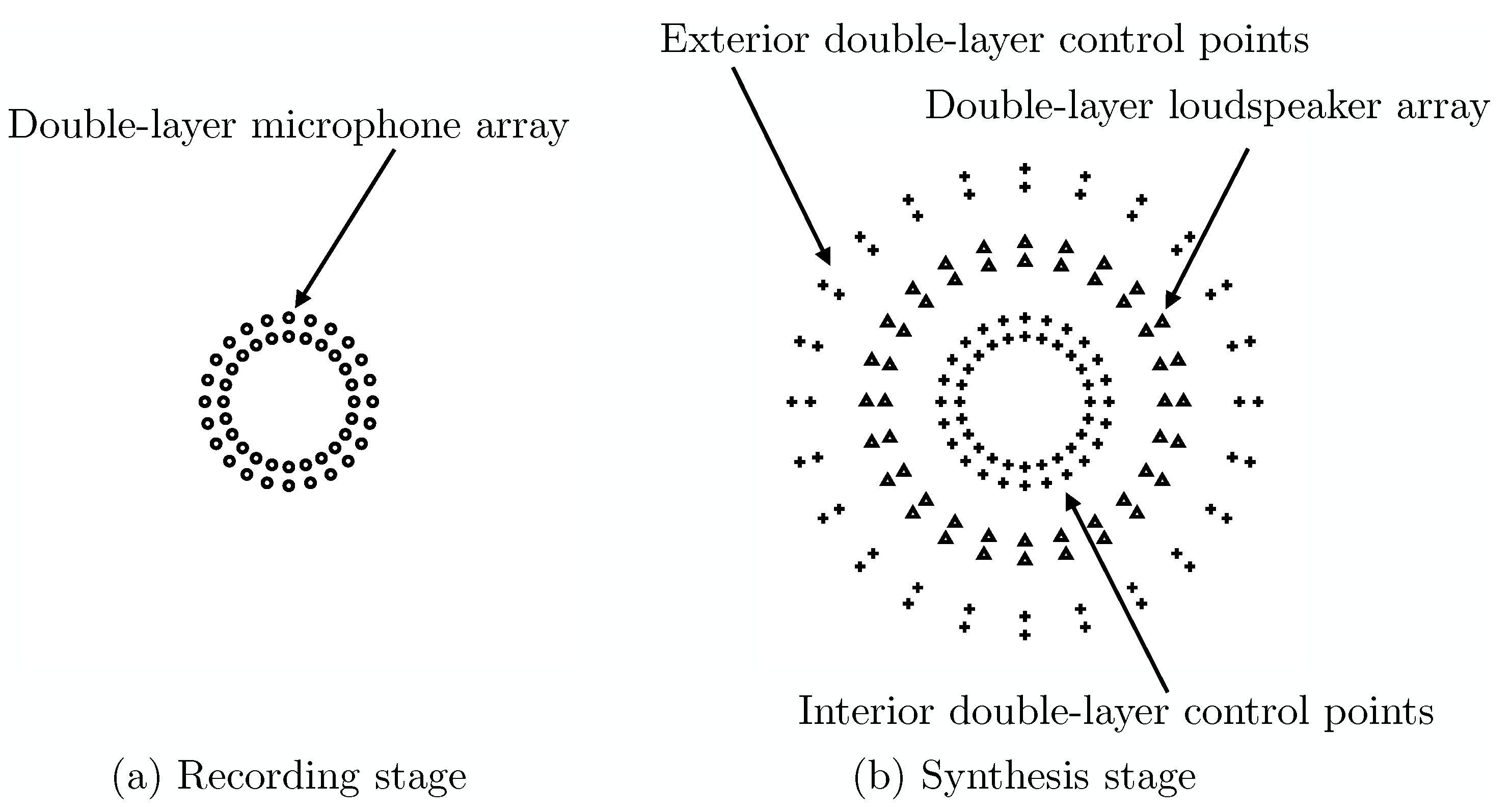

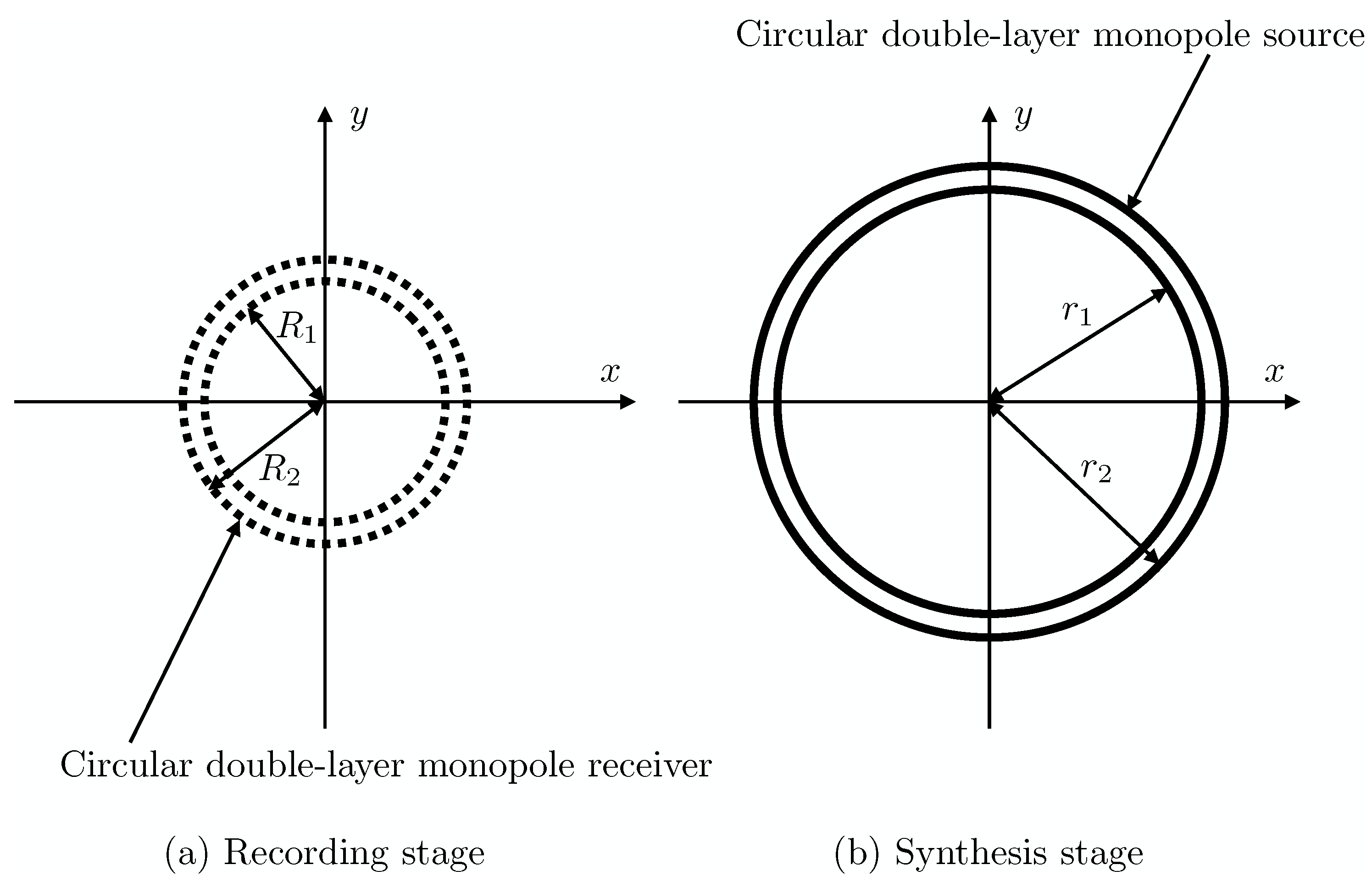
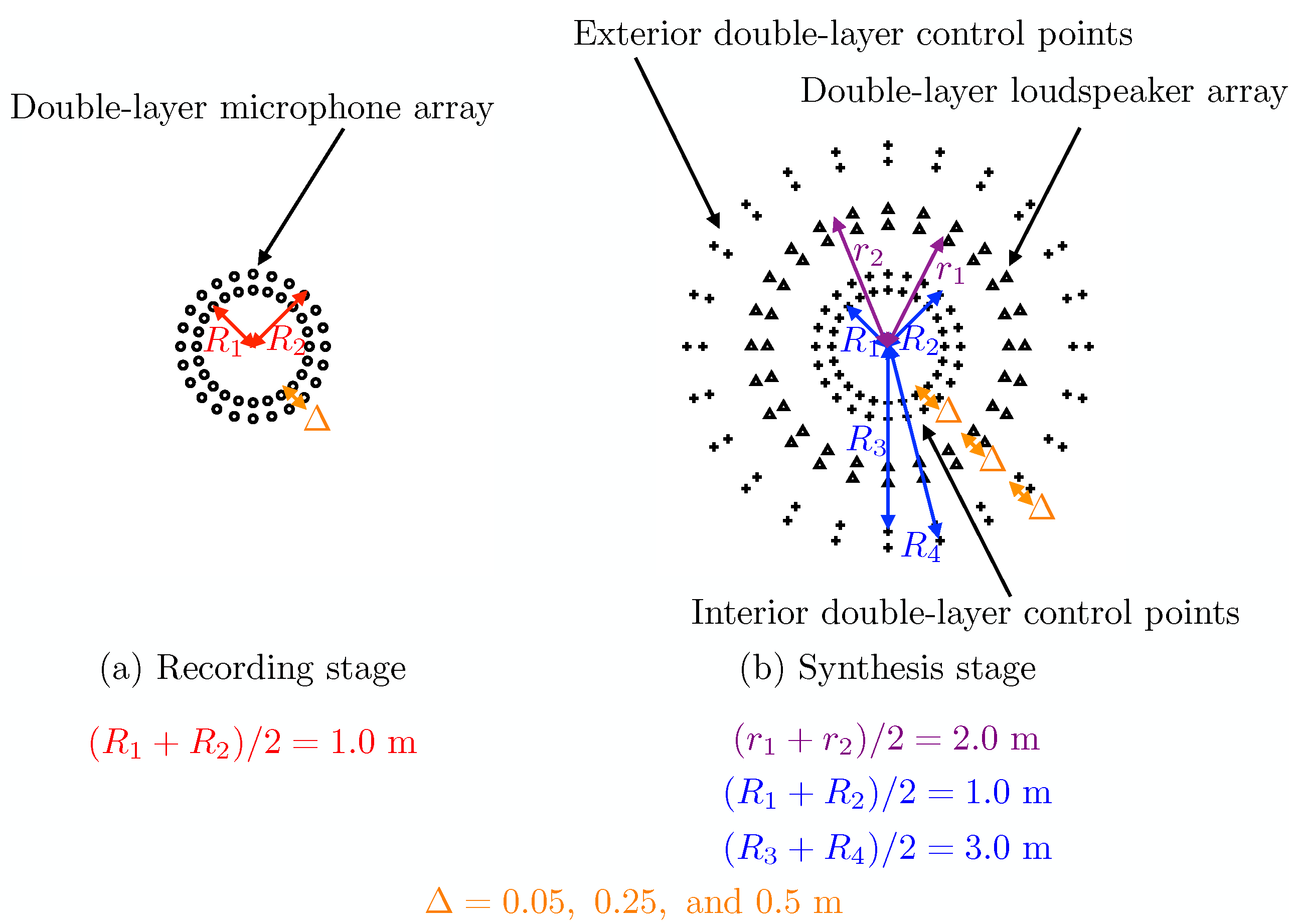
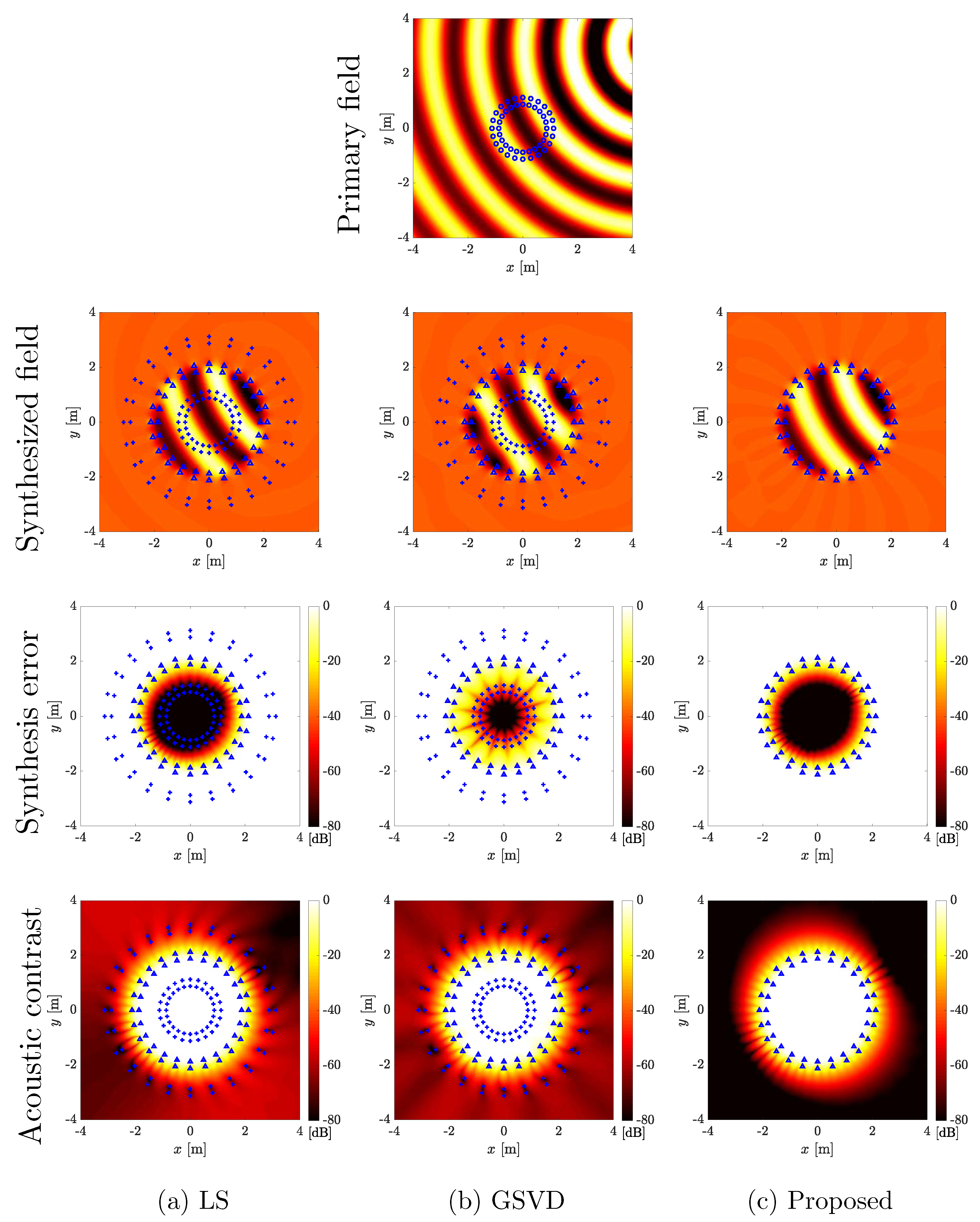
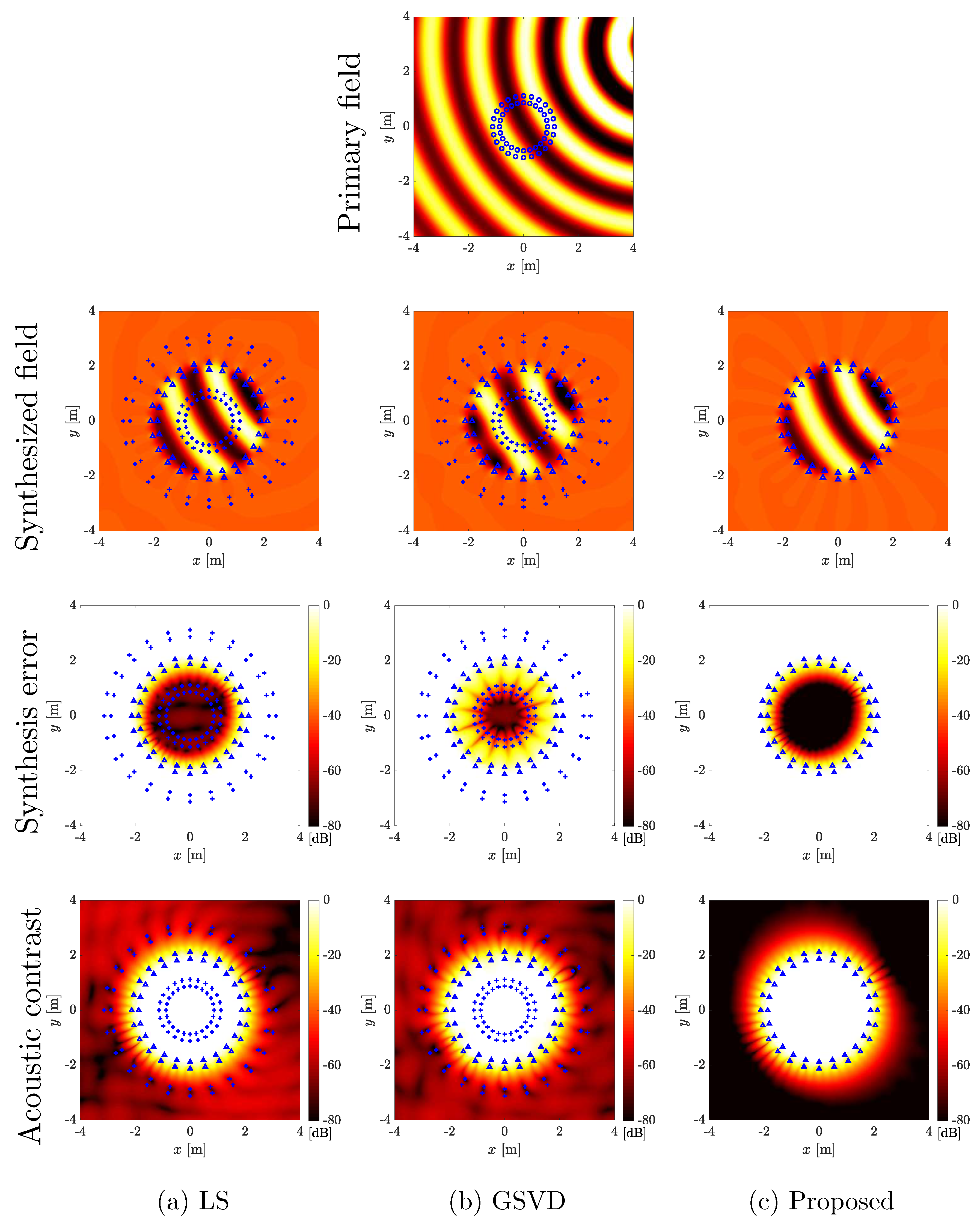
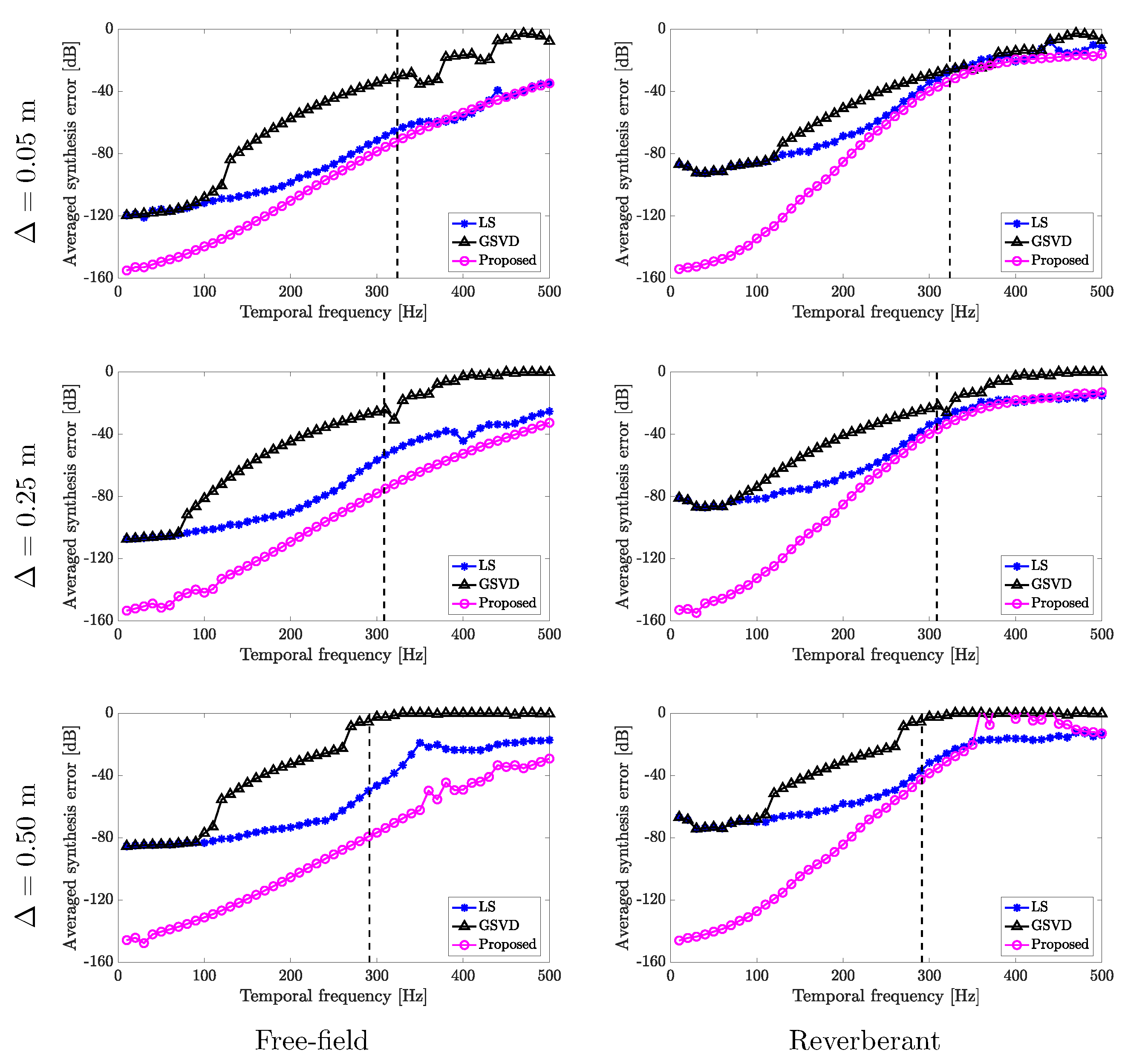
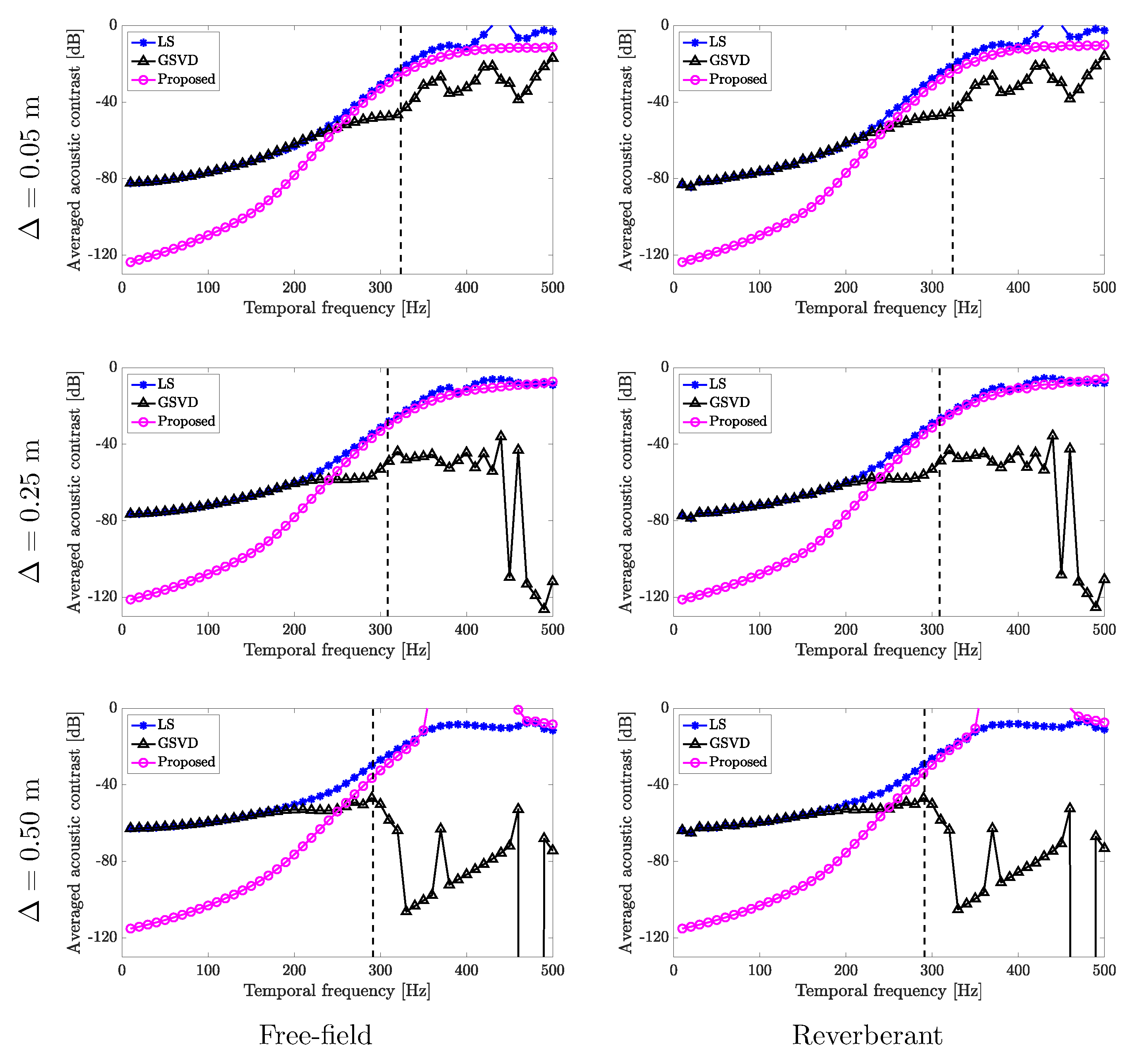

© 2018 by the author. Licensee MDPI, Basel, Switzerland. This article is an open access article distributed under the terms and conditions of the Creative Commons Attribution (CC BY) license (http://creativecommons.org/licenses/by/4.0/).
Share and Cite
Okamoto, T. Mode-Matching-Based Sound Field Recording and Synthesis with Circular Double-Layer Arrays. Appl. Sci. 2018, 8, 1084. https://doi.org/10.3390/app8071084
Okamoto T. Mode-Matching-Based Sound Field Recording and Synthesis with Circular Double-Layer Arrays. Applied Sciences. 2018; 8(7):1084. https://doi.org/10.3390/app8071084
Chicago/Turabian StyleOkamoto, Takuma. 2018. "Mode-Matching-Based Sound Field Recording and Synthesis with Circular Double-Layer Arrays" Applied Sciences 8, no. 7: 1084. https://doi.org/10.3390/app8071084
APA StyleOkamoto, T. (2018). Mode-Matching-Based Sound Field Recording and Synthesis with Circular Double-Layer Arrays. Applied Sciences, 8(7), 1084. https://doi.org/10.3390/app8071084




